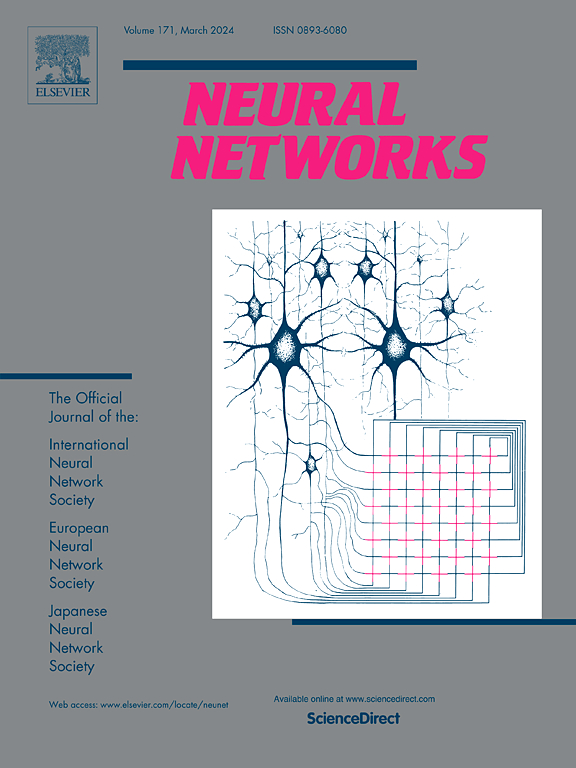基于角范数联合分类器的嵌入空间分配算法
IF 6
1区 计算机科学
Q1 COMPUTER SCIENCE, ARTIFICIAL INTELLIGENCE
引用次数: 0
摘要
FSCIL (few -shot class-incremental learning)的目标是从少数样本中不断学习新的类,而不会忘记以前的类,这需要智能体适应动态环境。FSCIL结合了类增量学习和少镜头学习的特点和挑战:(1)现有的类占据了整个特征空间,不利于学习新的类。增量轮次的少量样本不足以进行充分训练。在现有的主流虚拟类方法中,为了解决挑战(1),它们试图使用虚拟类作为占位符。但是,新类不一定与虚拟类一致。对于挑战(ii),他们用基于余弦相似性的最接近类均值(NCM)分类器替换可训练的全连接层,但NCM分类器不考虑样本不平衡问题。为了解决这些问题,我们提出了类中心导向的角范数联合分类器(SAAN)学习框架,该框架为所有类提供了平衡的空间,并利用样本不平衡引起的范数差异来增强分类标准。具体来说,对于挑战(i), SAAN将特征空间划分为多个子空间,并通过使用预先设置的类别中心引导样本为每个会话分配一个专用的子空间。对于挑战(ii), SAAN为每个类建立一个范数分布,并生成角范数联合逻辑。实验表明,SAAN可以达到最先进的性能,并且可以作为插件直接嵌入到其他SOTA方法中,进一步提高其性能。本文章由计算机程序翻译,如有差异,请以英文原文为准。
Embedding Space Allocation with Angle-Norm Joint Classifiers for few-shot class-incremental learning
Few-shot class-incremental learning (FSCIL) aims to continually learn new classes from only a few samples without forgetting previous ones, requiring intelligent agents to adapt to dynamic environments. FSCIL combines the characteristics and challenges of class-incremental learning and few-shot learning: (i) Current classes occupy the entire feature space, which is detrimental to learning new classes. (ii) The small number of samples in incremental rounds is insufficient for fully training. In existing mainstream virtual class methods, to address the challenge (i), they attempt to use virtual classes as placeholders. However, new classes may not necessarily align with the virtual classes. For challenge (ii), they replace trainable fully connected layers with Nearest Class Mean (NCM) classifiers based on cosine similarity, but NCM classifiers do not account for sample imbalance issues. To address these issues in previous methods, we propose the class-center guided embedding Space Allocation with Angle-Norm joint classifiers (SAAN) learning framework, which provides balanced space for all classes and leverages norm differences caused by sample imbalance to enhance classification criteria. Specifically, for challenge (i), SAAN divides the feature space into multiple subspaces and allocates a dedicated subspace for each session by guiding samples with the pre-set category centers. For challenge (ii), SAAN establishes a norm distribution for each class and generates angle-norm joint logits. Experiments demonstrate that SAAN can achieve state-of-the-art performance and it can be directly embedded into other SOTA methods as a plug-in, further enhancing their performance.
求助全文
通过发布文献求助,成功后即可免费获取论文全文。
去求助
来源期刊

Neural Networks
工程技术-计算机:人工智能
CiteScore
13.90
自引率
7.70%
发文量
425
审稿时长
67 days
期刊介绍:
Neural Networks is a platform that aims to foster an international community of scholars and practitioners interested in neural networks, deep learning, and other approaches to artificial intelligence and machine learning. Our journal invites submissions covering various aspects of neural networks research, from computational neuroscience and cognitive modeling to mathematical analyses and engineering applications. By providing a forum for interdisciplinary discussions between biology and technology, we aim to encourage the development of biologically-inspired artificial intelligence.
 求助内容:
求助内容: 应助结果提醒方式:
应助结果提醒方式:


